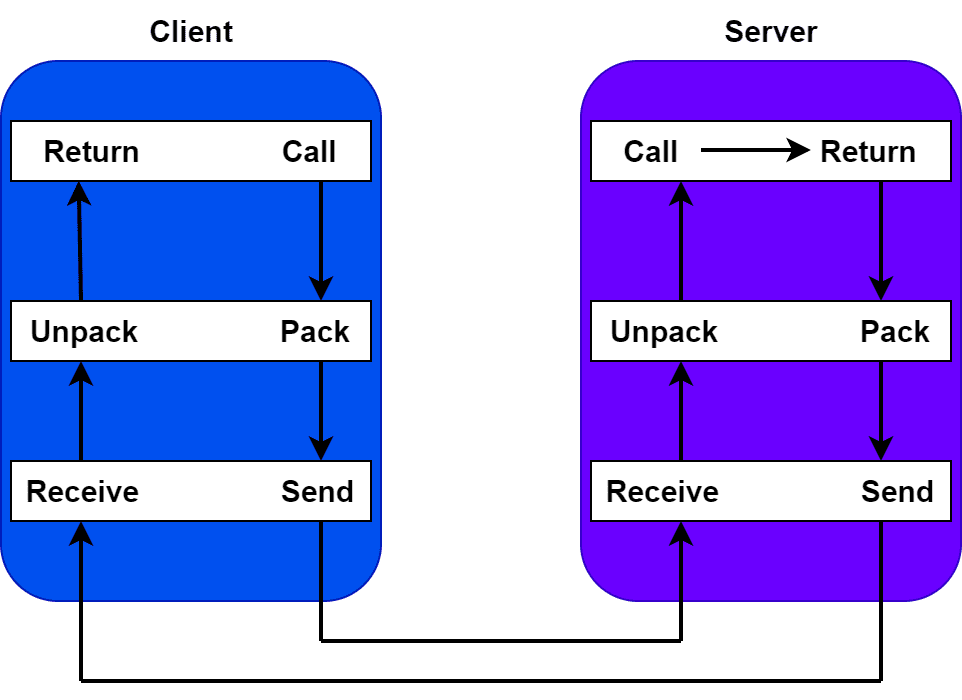1. 概述
本文将介绍两种常见的过程调用方式:本地过程调用(Local Procedure Call, LPC)和远程过程调用(Remote Procedure Call, RPC)。
我们会分别介绍它们的工作机制,并对比它们的核心差异,帮助你根据实际场景选择合适的技术方案。
2. 编程中的过程
在模块化编程中,过程是一段独立的代码模块,用于完成特定任务。它可以被多次调用,提升代码的复用性和可维护性。
过程与函数、例程或方法略有不同,但在本质上都是为了支持开发者在程序中重复调用逻辑。与传统的线性程序相比,使用过程能显著提升开发效率和代码结构的清晰度。尤其在复杂系统中,如果没有过程抽象,代码维护将变得非常困难。
过程通常由一个标识符(ID)和一段独立的代码组成。它既可以封装在对象中(面向对象编程),也可以作为外部库提供。
3. 过程调用简介
在算法语言中,过程通常包含两个基本操作:调用(call)和返回(return)。调用操作将程序控制权转移到另一个过程,执行完毕后返回原调用点继续执行。
调用过程时,可以传入参数,这些参数必须与过程定义中的参数类型和顺序一致,否则编译器会报错。
来看一个过程定义的例子:
procedure Show_Name(First_Name : in String, Last_Name : in String);
这是一个包含两个参数的过程:First_Name 和 Last_Name。
调用该过程的方式如下:
Show_Name("John", "Michael");
在分布式系统中,过程调用可能通过远程方式执行。过程调用可以在本地或远程执行,具体取决于系统架构:

4. 本地过程调用(LPC)
本地过程调用(LPC)是一种进程间通信机制,用于在同一台计算机上的不同进程或线程之间同步和通信。
LPC 支持同步和异步通信模式,通过端口(port)进行消息交换。操作系统通常会提供内置的工具来支持本地过程调用。
在 Windows NT 系统中,LPC 被广泛用于内部子系统之间的通信。许多本地客户端-服务器架构的应用程序也依赖于 LPC。
✅ LPC 的应用场景
- 同一主机上的多个应用程序需要通信
- 系统内部组件之间的通信
- 需要高性能、低延迟的本地通信
✅ Windows 中支持的 LPC 机制包括:
- 文件映射(File Mapping):用于共享文件内容和内存
- 套接字(Socket):支持本地网络通信(如 TCP/IP)
- 邮槽(Mailslots):允许本地进程间通信
- 数据复制(WM_COPYDATA):通过消息机制交换数据
5. 远程过程调用(RPC)
远程过程调用(RPC)是一种分布式计算模型,允许一个程序调用另一个地址空间中的过程,就像调用本地方法一样。
当客户端发起一个 RPC 调用时,线程会被阻塞,直到服务器返回结果。如果服务器未在指定时间内响应,可能会触发超时。
✅ RPC 的执行流程如下:
- 客户端提供过程 ID 和参数
- 客户端 stub 将请求发送到服务器
- 服务器接收请求并调用对应的处理函数
- 服务器执行完毕后将结果返回给客户端
- 客户端解除阻塞,继续执行
下图展示了 RPC 的典型流程:

✅ RPC 的核心组件包括:
- 运行时库(Runtime Libraries):负责网络通信和序列化
- 端点映射器(Endpoint Mapper):管理服务地址
- MIDL 编译器:用于生成接口桩代码
- 名称服务提供者(Name Service Provider):用于服务注册与发现
✅ 接口定义语言(IDL)
RPC 使用接口定义语言(Interface Definition Language, IDL)来定义远程接口。MIDL 编译器会根据 IDL 生成客户端和服务器端的桩代码,屏蔽底层通信细节。
这样,开发者可以像调用本地方法一样调用远程方法,RPC 框架会自动处理参数传递、网络通信和结果返回。
✅ RPC 的优势
- 屏蔽网络通信细节
- 支持跨平台通信
- 可以在本地或远程执行
- 支持自动数据格式转换(如 Windows RPC)
6. LPC 与 RPC 的核心区别
| 特性 | RPC | LPC |
|---|---|---|
| ✅ 调用范围 | 支持本地和远程 | 仅支持本地 |
| ✅ 是否需要网络 | 是(远程) | 否 |
| ✅ 性能 | 有网络延迟,较慢 | 本地通信,速度快 |
| ✅ 故障风险 | 可能因网络问题失败 | 不涉及网络,更稳定 |
| ✅ 设置复杂度 | 需配置远程服务 | 通常自动完成 |
| ✅ 跨平台支持 | ✅ 支持 | ❌ 仅限同一系统 |
| ✅ 应用场景 | 分布式系统、微服务、远程服务调用 | 本地进程通信、系统内部调用 |
7. 总结
本文介绍了本地过程调用(LPC)和远程过程调用(RPC)的基本概念、工作机制和核心区别。
- LPC 更适合本地进程间的高效通信,适合对性能要求高的场景;
- RPC 更适合跨机器、跨平台的远程调用,适合构建分布式系统;
在实际开发中,选择合适的调用方式非常重要。比如:
- 如果你在开发一个本地服务,需要多个模块之间快速通信,推荐使用 LPC;
- 如果你在构建一个分布式系统,需要调用远程服务,那 RPC 是更合适的选择。
✅ 建议:在使用 RPC 时,注意网络超时、重试机制、服务注册与发现等常见问题,避免踩坑。